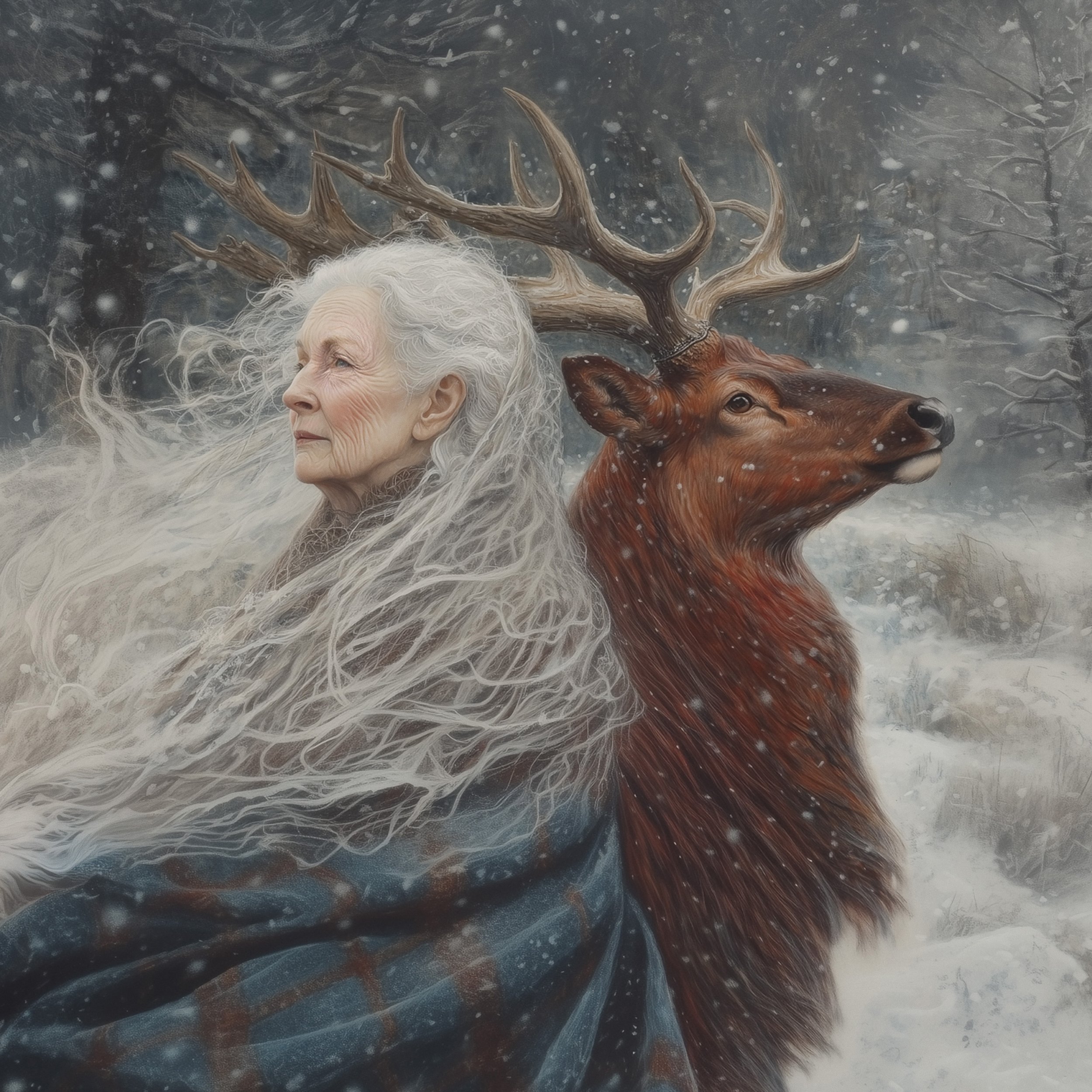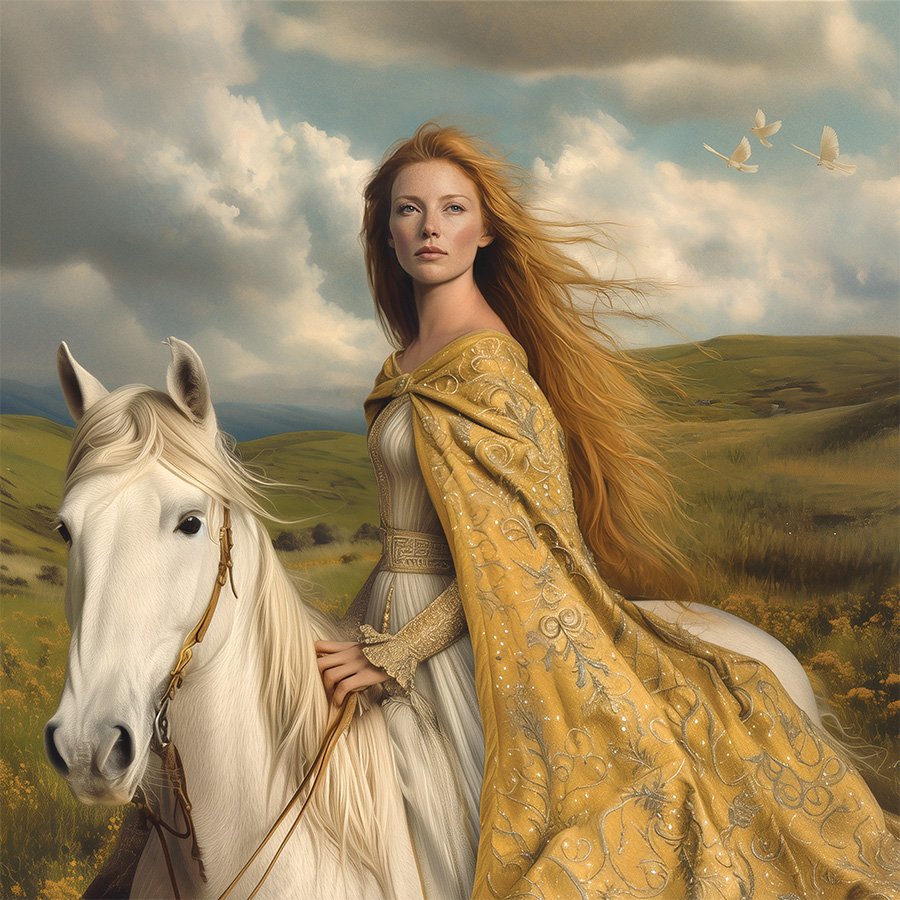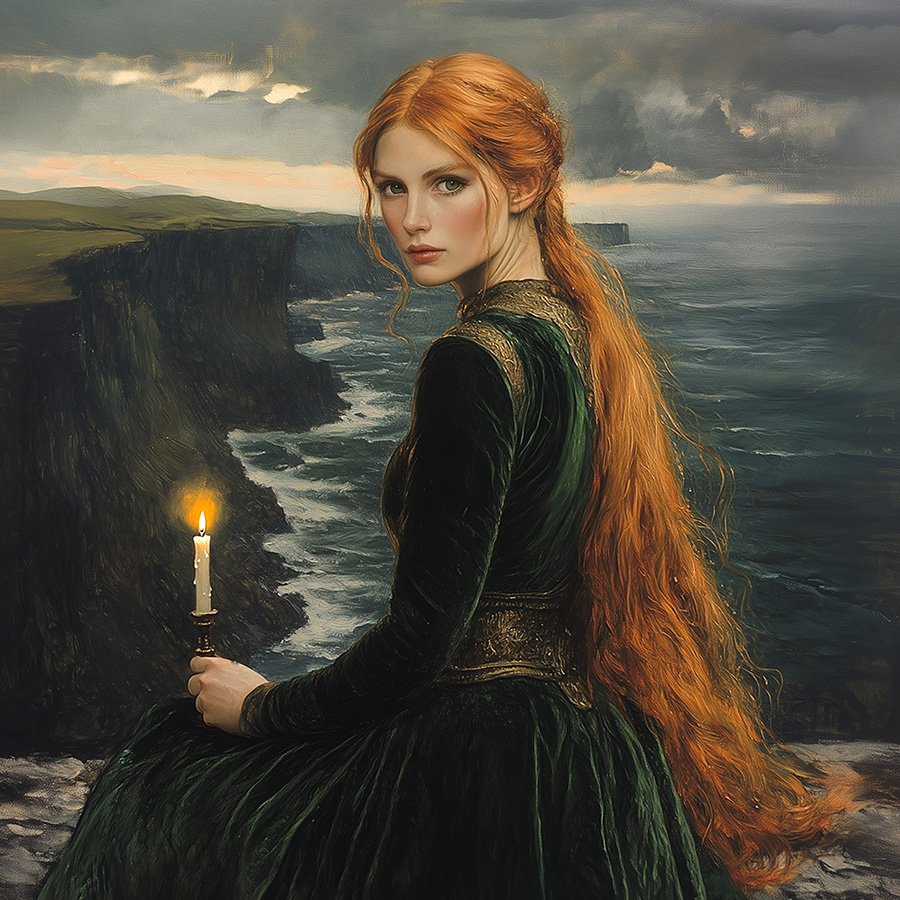The Cailleach
Brigid, a central figure in Celtic mythology, is revered as the goddess of fertility, healing, poetry, and smithcraft. Originating from ancient Ireland, she was celebrated as a bringer of spring and a symbol of renewal, her presence marked by the sacred flame tended in her temple at Kildare. Brigid's influence extended beyond her associations with fertility and healing to her role as a patron of the arts and crafts, inspiring both poets and metalworkers. Despite the rise of Christianity, Brigid's worship endures, with her festival Imbolc, celebrated on February 1st, reflecting themes of growth and new beginnings, and her legacy continues to inspire modern practitioners of Celtic spirituality.
Sedna
Selu, the revered goddess of corn in Native American mythology, is a central figure in the beliefs of several southeastern tribes, including the Cherokee and Creek. Created by the Great Spirit to provide sustenance, Selu is celebrated for her power to ensure a bountiful harvest and her nurturing nature. According to Cherokee mythology, Selu, the first woman and corn goddess, was killed by her sons who feared her magical abilities, but she instructed them to bury her body, transforming her essence into corn seeds to feed future generations. Today, Selu remains a symbol of wisdom, prosperity, and the cyclical nature of life, continuing to inspire spiritual practices and reverence in indigenous communities.
Rhiannon
Brigid, a central figure in Celtic mythology, is revered as the goddess of fertility, healing, poetry, and smithcraft. Originating from ancient Ireland, she was celebrated as a bringer of spring and a symbol of renewal, her presence marked by the sacred flame tended in her temple at Kildare. Brigid's influence extended beyond her associations with fertility and healing to her role as a patron of the arts and crafts, inspiring both poets and metalworkers. Despite the rise of Christianity, Brigid's worship endures, with her festival Imbolc, celebrated on February 1st, reflecting themes of growth and new beginnings, and her legacy continues to inspire modern practitioners of Celtic spirituality.
Vesna
As spring emerges across the northern hemisphere, the Slavic goddess Vesna symbolizes the season's renewal and vitality. Rooted in ancient beliefs, Vesna, often depicted as a youthful maiden adorned with flowers, embodies the cyclical battle between life and death, constantly struggling against Morana, the personification of winter. Celebrations like Maslenitsa and Kupala Night honor Vesna, blending pagan and Christian traditions to mark the arrival of spring with joyous rituals. Vesna's legacy continues to resonate, connecting people with their cultural heritage and the rhythms of nature, reminding us of the enduring promise of renewal and the interconnectedness of all life.
Skadi
Embark on a mythical journey through the Norse Pantheon with Skadi, the goddess whose essence embodies the harsh beauty of winter and the untamed wilderness of Nordic landscapes. Known for seeking justice for her father Thjazi’s death at the hands of Loki, Skadi’s quest for retribution brings her to Asgard, where she faces a peculiar challenge to select a husband by the sight of their feet, ultimately choosing the sea god Njord. Residing in Thrymheim, a celestial realm of snow-covered peaks, Skadi commands the icy winds and is revered by hunters and those seeking warmth and prosperity in winter’s harshness. Beyond her role as a winter deity, Skadi symbolizes justice, wisdom, and resilience, offering strength and inspiration to those facing adversity.
Selu
Selu, the revered goddess of corn in Native American mythology, is a central figure in the beliefs of several southeastern tribes, including the Cherokee and Creek. Created by the Great Spirit to provide sustenance, Selu is celebrated for her power to ensure a bountiful harvest and her nurturing nature. According to Cherokee mythology, Selu, the first woman and corn goddess, was killed by her sons who feared her magical abilities, but she instructed them to bury her body, transforming her essence into corn seeds to feed future generations. Today, Selu remains a symbol of wisdom, prosperity, and the cyclical nature of life, continuing to inspire spiritual practices and reverence in indigenous communities.
Amaterasu
Amaterasu, the Japanese sun goddess, shines as a central figure in Japanese mythology and Shinto religion. Her name, translating to "shining in heaven," reflects her role as the supreme deity and ruler of Takamagahara, the heavenly realm. Born from the left eye of the primordial deity Izanagi, Amaterasu embodies the sun's brilliance, symbolizing life, growth, and fertility. Revered as the guardian of rice cultivation and purity, her shrine at Ise Grand Shrine stands as one of Japan's most sacred sites. Amaterasu’s legends, including her retreat into a cave due to her brother Susanoo’s misdeeds and her subsequent return to bring light back to the world, underscore her vital role in maintaining harmony and prosperity.
the Morrigan
Celtic mythology reveals a profound depth through the figure of the Morrigan, the Great Queen or Phantom Queen. As a tripartite deity, she embodies three distinct aspects—Badb, Macha, and Nemain—each representing war, sovereignty, and chaos respectively. Known for her shape-shifting into a crow or raven and her ability to foretell death and battle outcomes, the Morrigan was central to Celtic beliefs about war and sovereignty. Today, she remains a symbol of strength and transformation, celebrated in modern Celtic and Pagan practices for her enduring power and influence.
Hel
Hel, a prominent figure in Norse mythology, embodies the intricate interplay between light and darkness as the guardian of the underworld. Daughter of Loki and Angrboða, her role as keeper of Niflheim underscores the duality of existence, marking a realm for souls who did not die in battle. Depicted as a living corpse or spectral figure, Hel symbolizes the balance between life and death. Her influence endures in modern culture and spiritual practices, representing the transformative journey through darkness and the cyclical nature of life.
Lilith
Lilith stands as a prominent figure in the Dark Goddess Pantheon, evolving from the rebellious first wife of Adam to a symbol of wild feminine power. Her mythology intertwines with various cultures and figures, reflecting her complex and shifting nature. Symbolically linked with serpents and the ouroboros, Lilith represents transformation, renewal, and the challenge to patriarchal norms. Her story underscores themes of sexual autonomy and the rejection of societal constraints, positioning her as a guardian of women’s empowerment and the untamed feminine essence.
Freyja
Freyja, the Norse goddess of love, beauty, and fertility, holds a prominent place in ancient Norse mythology. Worshiped since the pre-Viking era, she is celebrated for her allure, magical prowess, and role as the leader of the Valkyries, guiding fallen heroes to the afterlife. Freyja is often depicted with a cloak of falcon feathers and a chariot drawn by large cats, symbolizing her connection to both the physical and spiritual realms. Her influence extends into modern culture, inspiring Norse-inspired art, literature, and contemporary pagan practices, where she remains a powerful symbol of feminine strength and sensuality.
White Buffalo Calf Woman
White Buffalo Calf Woman, a revered figure in Lakota mythology, appeared to two hunters, marking a divine moment in their spiritual history. She imparted the sacred teachings of the Seven Sacred Rites and gifted the Lakota people with the Chanunpa, or Sacred Pipe, which symbolizes the connection between the human and the divine. Her teachings emphasized purity, respect, and unity, shaping essential spiritual practices within the Lakota tradition. The white buffalo, a manifestation of her presence, remains a powerful symbol of hope and renewal.
Brigid
Brigid, a central figure in Celtic mythology, is revered as the goddess of fertility, healing, poetry, and smithcraft. Originating from ancient Ireland, she was celebrated as a bringer of spring and a symbol of renewal, her presence marked by the sacred flame tended in her temple at Kildare. Brigid's influence extended beyond her associations with fertility and healing to her role as a patron of the arts and crafts, inspiring both poets and metalworkers. Despite the rise of Christianity, Brigid's worship endures, with her festival Imbolc, celebrated on February 1st, reflecting themes of growth and new beginnings, and her legacy continues to inspire modern practitioners of Celtic spirituality.














